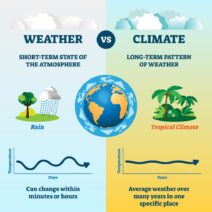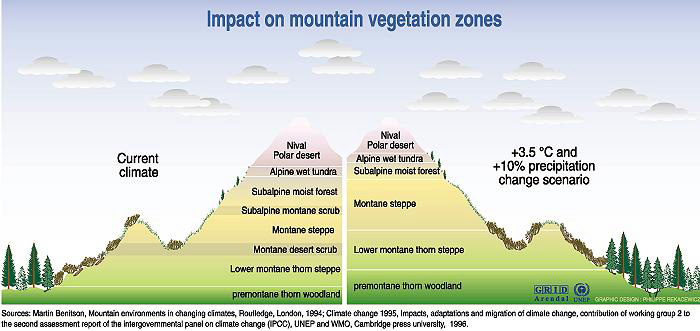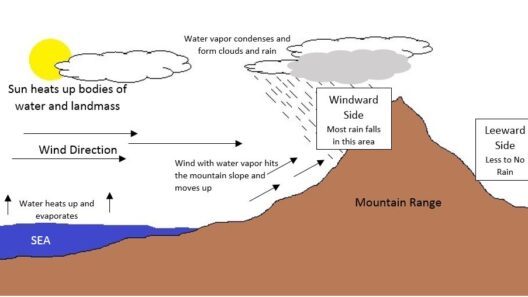Mountains, those towering titans of the Earth, are more than mere geographical features; they are formidable guardians of varied ecosystems, serving as bastions of biodiversity while also shaping the very climate that envelops them. Like the changing characters in a grand play, these elevations wield an influence over the atmospheric conditions that create intricate microclimates. Understanding the relationship between elevation and weather is akin to deciphering a complex piece of music; each note, each change in pitch or tempo alters the overall symphony.
At base level, the expansive world appears uniform, but as one ascends, the stage transforms dramatically. The myriad ecosystems that thrive at different elevations mirror a tapestry woven from distinct threads of climate. The interplay between altitude, temperature, and moisture is pivotal, crafting microclimates that encapsulate unique environments. For instance, the gentle foothills may cradle lush temperate forests, while only a few miles away, the crest of a mountain could be crowned with stark alpine tundra. This stark contrast highlights the mountain’s ability to dictate localized weather patterns.
One of the most pronounced phenomena in mountainous terrains is the orographic effect. As moist air rises to meet the mountain’s slopes, it cools, and condensation occurs, leading to the formation of clouds. This natural process is the crux of precipitation generation, whereby the windward side of the mountain receives copious rainfall, while the leeward side, often referred to as the rain shadow, remains arid and parched. This dichotomy is striking—on one flank, verdant forests may flourish, while on the other, a desert landscape emerges. The persistence of these contrasting conditions affirms that elevation is a master sculptor of climate.
Temperature fluctuations also play a pivotal role in differentiating microclimates. As elevation increases, the air becomes thinner and less able to retain heat. Typical temperature drops of approximately 6.5 degrees Celsius per 1,000 meters rise dictate that the summits are often enveloped in snow and ice, even when valleys below bask in sunlight. This variation creates habitable zones at multiple tiers, fostering unique flora and fauna suited to their respective climatic niches. For instance, one can encounter broadleaf forests giving way to coniferous woodlands, which in turn may transition to alpine meadows, distinctly illustrating the vertical layering of biodiversity.
Microclimates are not only defined by elevation but are also influenced by the orientation of mountain slopes. South-facing hillsides, which bask in sunlight for a more extensive part of the day, tend to host warmer climates and are often adorned with different species than their north-facing counterparts, which remain shrouded in shade. These contrasting exposures generate a mosaic of habitats, each with its own unique array of life. These subtle but profound differences underscore the mountain’s role as a climatic conductor, orchestrating an ensemble of environmental conditions.
Additionally, the journey of water through mountainous landscapes is a narrative of its own. Snowmelt feeds rivers and streams, restoring life to ecosystems downstream, nurturing everything from forests to wetlands. Seasonal variations in snowfall lead to different microclimates, impacting the flora and fauna drastically. The slow release of water from melting snowpack ensures that ecosystems have a steady supply, fostering resilience amid changing weather patterns. This reliance on snowmelt renders mountain ranges as vital water towers for entire regions, shaping agricultural practices and human settlements below.
As climate change continues to unfold, its impacts on mountainous regions are becoming increasingly pronounced. The delicate balance of altitudinal ecosystems is threatened by rising temperatures. Species that flourished at higher elevations may find their habitats shifting upward, leaving them with less and less room to adapt. Additionally, the changing patterns of precipitation threaten to disrupt the reliable snowmelt that sustains many freshwater ecosystems. In this way, mountains act as early warning systems, their changing climates offering valuable insights into broader environmental shifts.
Furthermore, the cultural significance of mountains in relation to microclimates animates human stories. Indigenous communities often possess remarkable knowledge of their local environments, perfectly attuned to the nuances of altitude and climate. Traditions, agriculture, and even spiritual beliefs are intricately tied to the unique environmental conditions found in mountainous terrains. This human connection to nature emphasizes the importance of preserving these delicate ecosystems and understanding the impacts of environmental changes.
In conclusion, the complex relationship between mountains and microclimates reveals the dynamic nature of our planet. Like a carefully crafted sonata, each elevation, each slope, and each climatic nuance contributes to the overarching harmony of the environment. As stewards of the Earth, understanding these relationships is essential for fostering conservation efforts and ensuring that the dramatic beauty of mountain landscapes continues to flourish for generations to come. Embracing the challenges presented by climate change requires not only acknowledgment but also a commitment to sustaining the remarkable intricacies that define mountainous ecosystems. In this noble quest for preservation, we find not only an urgent call to action but also a deeper appreciation for the majestic World Mountains, our silent sentinels of climate.








